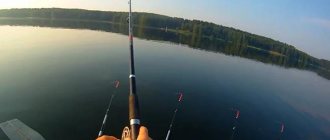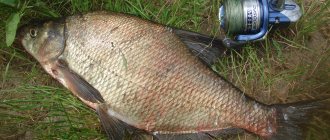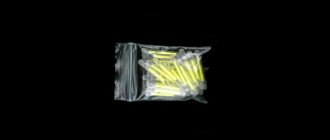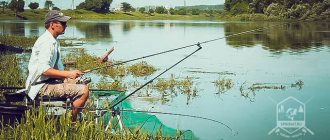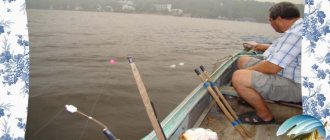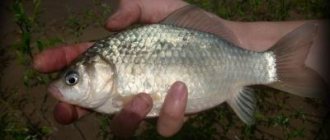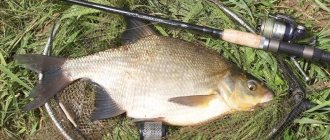What are the advantages and disadvantages of fishing with a feeder from a boat?
Let's start with the shortcomings.
- the main thing is that the feeder, even a small one, is always more massive and has a longer rod than the side tackle. It was created specifically to make long-distance casts with maximum accuracy, while it is more convenient to make short casts from a boat;
- if you don’t balance your swing, you may end up in the water, which is not very pleasant, especially on a bad day;
- in strong winds or currents it is often difficult to keep track of the tip, which makes fishing difficult, and sometimes you have to cancel it completely;
- In itself, being on a boat for a long time is physically difficult, you can withstand up to eight hours at most, but a person is not made of iron, you need to stretch your legs and want to eat, but there is not always somewhere to put things. It's simply difficult without a toilet. In addition, if the boat is rubber, then it is less stable than a wooden one. Standing up to stretch your stiff legs is simply dangerous;
- It’s difficult, out of habit, to untangle a fishing line that has become tangled at the tip - the gear takes up a lot of space and you can’t, like on the shore, put it on stands and do everything calmly. In this case, move the feeder along the boat to reach the tip and try not to wet the reel in water again. It is clear that to most fishing enthusiasts such things seem unnecessary and tedious fuss.
We're done with the disadvantages, now let's move on to the advantages. You will see that not everything is so bad. There are quite a few advantages to fishing on a feeder from a boat.
- sitting on the shore, you can cast gear only in a limited space, and no one has canceled the competitors who have already taken all the good places before you. When you are in a boat, the area of “influence” on the water area increases greatly, and the likelihood of interference from neighbors decreases;
- tranquility and privacy. An excellent advantage compared to the shore, especially if it was suddenly chosen by some noisy company;
- the watercraft makes it possible to study the reservoir in detail, and if you have an echo sounder, then you will even be able to map out the bottom topography, choosing the most fishing spots. You can swim to an area where you can’t get the tackle from the shore, which significantly increases the chances of surprising your family with a rare trophy;
- more dynamics. Free movement is convenient for experimenting and gaining experience. You can try different options for bait, flavors, baits, and also try all sorts of equipment and leashes, and then fish many places that seem promising to you and choose the best;
- When fishing on a feeder from a boat, there is no point in throwing a feeder over a long distance. You place it a few meters away from you, and sometimes just nearby, which greatly saves time on casting and retrieving gear, and the efficiency of feeding increases. You don’t need to practice your accuracy; the fishing process becomes noticeably more comfortable;
- the possibility of the most accurate baiting at a given place, regardless of the current;
- If you catch a large fish, it will be easier to fish it out from the boat and bring it to the landing net, without the risk of running into a snag or getting tangled in algae, which are so often found near the shore and spoil everything at a crucial moment.
Lure
In many ways, such an effective fishing method as “ring fishing” played a role in the adaptation of feeder gear to fishing from a boat. This method is used only in river fishing. Its effectiveness is based on the abundant feeding of fish using a large-volume feeder.
Using a feeder when fishing from a boat allows
- feed the place with maximum accuracy, regardless of the strength of the current in the reservoir;
- create a constant concentrated spot of bait;
The fisherman simply lowers the bait with a feeder into a suitable place. The total volume and composition of the bait depends on the time of year and the characteristics of the behavior of the fish in this particular body of water. Typically, anglers in the process of baiting are guided by the following rules:
- Initial bait - at least 1/3 of the total volume;
- The remaining volume is supplied evenly at equal (but not more than 10 minutes) intervals.
These rules are not dogma, but on an unfamiliar body of water it is better to adhere to them.
Complementary foods are prepared in advance. Best in the evening. It is usually made with porridge. Overnight, the porridge will thoroughly infuse and swell, acquiring the necessary viscosity.
It is very important to feed the area correctly. Complementary feeding can be done in two ways: using a slingshot or a feeder.
For the slingshot, dense balls with a diameter of about 7 centimeters are made and launched as accurately as possible into the feeding areas. For one feeding you need to launch from 3 to 6 such balls.
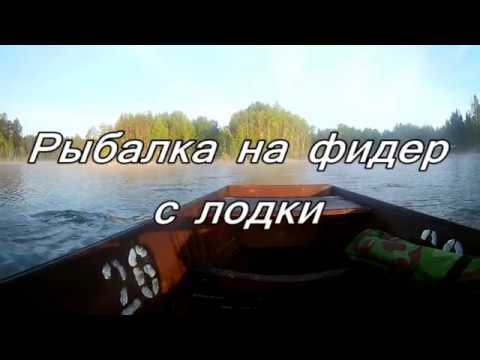
If there is no bite, then more complementary food will be needed to effectively lure fish. The amount of food in the feeder will depend on its size.
Fishing with bottom tackle involves the use of bait. You can buy it at the store or prepare it yourself. The main thing is to know which fish prefers which bait. Various porridges, breadcrumbs, Hercules, corn, peas, potatoes, semolina, etc. are used. Knowing the cooking technology, you can prepare bait no worse than factory bait.
To enhance the effect of the bait mixture, which essentially should attract fish, flavors and attractants are added to the mixture. These chemicals enhance the odors of the natural components of the bait.
There is debate about this among fishermen: some talk about the advisability of using such chemicals, while others claim that they scare away certain species of fish. This is also due to the fact that it has not yet been established how these chemicals act on living organisms.
And yet, as practice shows, white fish do not refuse such bait and, so that fishing does not turn out to be ineffective, fishermen still add attractant flavors to the mixture.
It is best to prepare the mixture on the shore, since it will be inconvenient to do this in a boat, especially in the current. Dry ingredients are usually mixed with water from the same reservoir in which the fish will be caught, although some fishermen did not notice the difference. If a fish is caught, it is caught using bait mixed in any water and from any body of water.
The consistency of the bait is selected from the condition that it should be washed out of the feeder within 5-7 minutes. Bait that is too viscous, with too much liquid, will linger in the feeder and will not attract fish properly. If it is too dry, it will be washed out from the feeder even before it sinks to the bottom and, especially, will not perform its functions.
And here's what you need to know: Flies for catching Grayling, Lenok, Trout, Char
Typically, fish are attracted to a cloud of turbid water in the area where the feeder is located. In order for such a spot to form, fishermen add various components to the bait that contribute to the formation of such a spot. These can be highly crushed (in a blender) solid additives (crackers, peas, corn, etc.) or, sometimes fishermen do this, add ordinary clay or soil to the mixture.
Which feeder is more convenient for fishing from a boat?
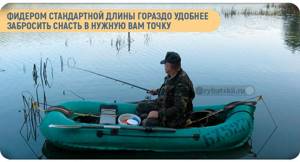
There are two opinions about which boat feeder will be better. Oddly enough, these opinions are opposite. Let's look at both.
Standard feeder with rod length from 3.3 to 3.9 meters
At first it may seem that fishing with such a cumbersome device is quite difficult, but there are a number of important advantages: it makes it easier to throw the gear to the chosen point and it is easier to direct the caught fish where we need it, especially large ones like ide, carp or carp, which often tangle the fishing line.
An improvement can be made by making the feeder smaller. After all, the casting distance has become much shorter, which saves time and makes fishing a more dynamic process with frequent changes of feeder. You need to set the tip to the most sensitive one, take a monofilament line and a small spool for the reel.
Short side feeder
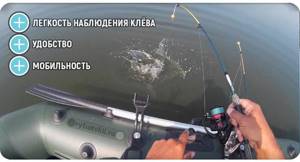
Proponents of this method put forward the following arguments: placing a small tackle is much more convenient and it will be easier to monitor the bite. A short feeder is more mobile. When you hook a large prey, you have to tire the fish away from the boat. This tactic will avoid the equipment getting tangled in the anchor ropes.
A short feeder must have special equipment: choose a paternoster or an asymmetrical loop. The length of the leash can be taken from 50 to 100 cm, you will understand this through experience. The paternoster is great for catching bream on a feeder from a boat, and such installation can be done within a minute right before the start of fishing.
The feeder rod equipment must meet the following parameters:
- minimal possibility of the leash getting tangled around the equipment and cord;
- absence of massive parts and ease of manufacture;
- high sensitivity when biting.
Why do we need feeders?
When catching large specimens, a large load is placed on the top of the spinning rod. With sudden jerks, it may become deformed or break. This is true when using braiding with a minimum stretch value. To compensate, standard bream fishing equipment includes a feeder.
How to make a fishing box for winter fishing with your own hands: selection of materials and manufacturing procedure
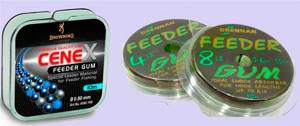
This is a shock absorber made of very dense rubber. It partially absorbs the load and reduces the number of jerks. Recommendations for use of feeders:
- attached at the base of the fishing line, in front of the leash;
- maximum insert length – up to 15 cm;
- loop-loop fasteners for quick dismantling and replacement;
- Used only for catching large fish.
A standard configuration feeder device usually does not have this component. But it is advisable to have it in the set. If a big fish bites, you can always quickly install a shock absorber.

How to choose a fishing spot
Bottom fish are not distributed evenly throughout the reservoir. Her favorite places are different holes, differences between depths, as well as heterogeneities, i.e. boundaries of bottom sediments, bare areas among algae, or, conversely, pieces of clean bottom overgrown with algae. Even if this is not your first time fishing on this reservoir, it doesn’t hurt to study the bottom again, because it may change. There are several ways to do this:
- measured with cargo;
- marker equipment;
- drawing;
- If you have an echo sounder, the problem can be solved immediately.

However, many people believe that you can do without studying the bottom if you don’t have an echo sounder. After all, by creating the right bait, you will perfectly lure the fish where you want them. An experienced fisherman always knows where the edges are located, and he swims there. If there are no edges, then nothing will prevent you from placing the craft right in the middle of the river in the riverbed and having a great time catching fish there, unless there is a strong current in the river that will carry away the bait. Also, experienced professionals are able to determine by eye the correct place by protruding snags, whirlpools, etc.
If the bottom depth is more than 8-10 meters or the water is cloudy, then the fish will not notice the shadow. You can position yourself directly above a promising site.
How to install a boat
The main thing is to position the craft so that it is not tossed around in the water by the wind and current, and you do not lose the place where you placed the bait.
It's worth taking the time to set up the boat so that your fishing doesn't end up being ruined. But your efforts will later pay off with a good catch, because as the famous cartoon hero said, it’s better to lose a day and then fly in five minutes.
You certainly won't spend a day on installation. You just need to do the following:
- set the bow anchor in the chosen location;
- we sail downstream or just wait until it drifts 10-20 meters;
- then we throw the stern anchor back or pull the boat forward so that the anchor is behind.
Now your boat is securely secured by two anchors and will not move anywhere, it will only react to a strong side wind. If you are fishing together, you can create a trail of bait, which will improve your chances.
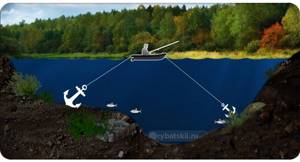
Some place the craft across the current. The principle is the same: throw anchors away from the boat.
What other nuances to consider when fishing with a feeder from a boat?
It is useful to note that when fishing on a feeder this way, you don’t have to fill the feeder with bait as tightly as on the shore. The fact is that when fishing on the shore, the feeder clings to uneven surfaces and some of the bait spills out of it, but when fishing with a feeder from a boat, this will not happen.
When choosing a watercraft, consider how you will get to the place of quiet hunting. If you have a long journey ahead, then the ideal choice is a PVC boat. It is not as bulky and heavy as swimming devices made of metal and wood.
Selection of baits and baits
To feed bream or other similar fish, you need to choose the right bait. It is placed in a feeder, the requirements are density, aroma and taste that attracts fish. The traditional recipe is semolina cooked in the form of a thick porridge. When fishing, it can be cut into slices and placed in baits.

For flavor when fishing with a feeder on a current, you can add the following ingredients to the bait:
- Vanillin. A synthetic cheap analogue is recommended, since bream are attracted precisely by the smell of this component.
- Fennel. Used for catching trophy specimens. Advantages: a small portion is required to create the aroma; the ingredient has proven itself well during summer fishing.
- Cinnamon. Goes well with all types of bait.
You can use canned corn. To increase the likelihood of a good catch, experienced fishermen use bait of animal origin - dung worms, bloodworms, maggots. They often try the effectiveness of combining it with traditional porridges.
Fishing process
Let us briefly describe the process itself. After you have reached the reservoir and set the watercraft on the stretch, make sure that everything is done conscientiously and you will not be carried away if you are going to fish on a river with a current. Then you fill the feeder with bait, put the bait on the hook and throw it into the place where you created the bait spot.
The first feeding should be made no less than a third of the total volume, and then feeding should be done no later than every 10 minutes.
Fishing is carried out vertically, so the bite alarm (quivertip) has the highest degree of sensitivity. Wind the line so that it is slightly bent.
In the first half hour, small things may be caught, “serious” prey comes later, and it is not so easy to predict when this will happen. Small things can be cut off by increasing, for example, the size of the hook.
When a large fish finally appears, the tip straightens or bends. The hook must be short and sharp. There is no need to force the fight. Let the trophy wear out while you reel in the line and allow the trophy to pull it during the jerks. When the fish gets tired, you can take it into the landing net.
